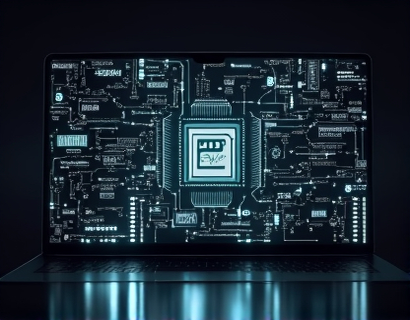Mastering DeFi Management with a Next-Gen Web3 Wallet
In the rapidly evolving landscape of decentralized finance, or DeFi, managing digital assets efficiently and securely is paramount. The advent of Web3 technology has ushered in a new era of online wallets designed to simplify the complex processes of accessing, storing, and transacting cryptocurrencies and tokens. This article delves into the features and benefits of a cutting-edge Web3 wallet, tailored to meet the needs of crypto enthusiasts and DeFi users who demand seamless and secure digital asset management.
Understanding Web3 Wallets
Web3 wallets represent the next generation of digital asset management tools, built on blockchain technology to provide users with greater control and security over their cryptocurrencies and tokens. Unlike traditional wallets, Web3 wallets are decentralized, meaning they do not rely on central authorities or intermediaries. This decentralization is a cornerstone of the DeFi ecosystem, promoting transparency, security, and user autonomy.
The primary function of a Web3 wallet is to serve as a secure repository for digital assets, allowing users to manage multiple cryptocurrencies and tokens from a single interface. These wallets utilize advanced cryptographic techniques to ensure that private keys, the essential component for accessing and transacting assets, remain under the user's control at all times.
Key Features of a Next-Gen Web3 Wallet
A state-of-the-art Web3 wallet offers a suite of features designed to enhance the user experience and provide robust security measures. Some of the key features include:
- Multi-asset support: Seamlessly manage a wide range of cryptocurrencies and tokens, from popular ones like Bitcoin and Ethereum to lesser-known altcoins and tokens.
- User-friendly interface: Intuitive design that simplifies navigation and transaction processes, making it accessible even for those new to crypto and DeFi.
- Enhanced security: Advanced encryption methods and multi-signature capabilities to protect against unauthorized access and potential hacks.
- Real-time transaction tracking: Monitor transactions and balances in real-time, providing immediate insights into asset movements and portfolio performance.
- Customizable alerts: Set up notifications for price changes, transaction confirmations, and other important events to stay informed and make timely decisions.
- Integration with DeFi protocols: Seamless connectivity with decentralized finance protocols, enabling users to participate in lending, borrowing, staking, and yield farming opportunities.
Simplifying Access and Storage
One of the most significant advantages of a Web3 wallet is its ability to simplify access and storage of digital assets. Traditional wallet solutions often require users to download and manage multiple applications, each for a specific cryptocurrency or token. In contrast, a Web3 wallet consolidates these functions into a single, easy-to-use platform.
Accessing assets is as simple as logging into the wallet interface, where users can view their entire portfolio at a glance. The wallet supports various blockchain networks, ensuring compatibility with a broad spectrum of cryptocurrencies and tokens. This universality eliminates the need for users to maintain separate wallets for different assets, reducing complexity and potential security risks.
Storage of private keys is another critical aspect. Web3 wallets employ hardware-based security modules or secure enclaves to store private keys offline, shielding them from online threats. This offline storage, combined with robust encryption, ensures that even if a user's device is compromised, their assets remain safe.
Streamlining Transactions
Transactions are a core component of DeFi, and a next-gen Web3 wallet is designed to streamline this process. The wallet interface provides a straightforward process for initiating transactions, whether it's sending or receiving cryptocurrencies or tokens.
The transaction process typically involves selecting the asset, entering the recipient's address, and specifying the amount. The wallet then generates a transaction request, which is signed using the user's private key. This signature ensures that the transaction is authorized and can only be executed by the rightful owner.
To enhance convenience, Web3 wallets often include features like transaction batching and bulk transfers, allowing users to manage multiple transactions in one go. Additionally, integration with smart contracts enables users to automate transactions based on specific conditions, further simplifying the process.
Enhancing Security Measures
Security is non-negotiable in the world of cryptocurrencies and DeFi. A cutting-edge Web3 wallet incorporates multiple layers of security to protect user assets. Here are some of the advanced security features:
- Multi-factor authentication (MFA): Adds an extra layer of security by requiring users to verify their identity through multiple methods, such as a password and a one-time code sent to a mobile device.
- Biometric authentication: Some wallets support fingerprint or facial recognition for a more secure and convenient login process.
- Backup and recovery options: Users can create recovery phrases or seeds to restore access to their wallet in case of loss or forgetfulness of login credentials.
- Regular security audits: Reputable Web3 wallet providers undergo frequent security audits to identify and mitigate potential vulnerabilities.
- Isolation of sensitive data: Private keys and other sensitive information are stored in isolated environments, minimizing the risk of data breaches.
User Experience and Accessibility
A superior Web3 wallet prioritizes user experience and accessibility, ensuring that the platform is intuitive and easy to navigate. The interface is designed with the user in mind, featuring clear menus, straightforward navigation, and helpful tooltips to guide new users.
For those who prefer a more hands-on approach, the wallet also supports advanced features such as customizable dashboards, where users can tailor the interface to display the information most relevant to them. This personalization enhances the overall user experience, making the wallet more efficient and user-friendly.
Accessibility is another crucial aspect. The wallet is optimized for use across various devices, including desktops, laptops, tablets, and smartphones. This cross-platform compatibility ensures that users can manage their assets anytime, anywhere, as long as they have an internet connection.
Integration with DeFi Protocols
One of the most powerful aspects of a Web3 wallet is its integration with decentralized finance protocols. This integration opens up a world of opportunities for DeFi users, allowing them to participate in a wide range of financial activities.
Lending and borrowing platforms enable users to earn interest on their assets or borrow cryptocurrencies with favorable terms. Staking platforms allow users to lock their assets to support the operation of blockchain networks, often earning rewards in the form of additional tokens. Yield farming is another advanced strategy where users deploy their assets across multiple DeFi protocols to maximize returns.
The wallet simplifies these processes by providing direct links to popular DeFi platforms and automating the necessary steps, such as signing transactions and managing contracts. This seamless integration empowers users to fully leverage the potential of DeFi without needing extensive technical knowledge.
Conclusion
In the dynamic world of decentralized finance, a next-gen Web3 wallet is an indispensable tool for crypto enthusiasts and DeFi users. By offering seamless access, robust security, and streamlined transactions, these wallets simplify the complex processes of managing digital assets. As the DeFi ecosystem continues to grow and evolve, the importance of a reliable and user-friendly Web3 wallet becomes increasingly evident. Embracing this technology not only enhances the user experience but also opens up new possibilities for participation in the decentralized financial landscape.










































